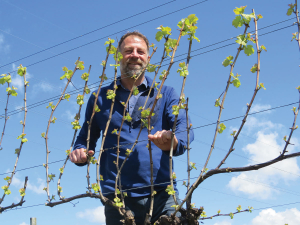Jim White joins NZ Winegrowers board
Jim White has been elected to the New Zealand Winegrowers board following a levy class director by-election in July.
 Cloudy Bay’s Jim White with one of six trials being run as a precursor to a BRI research programme. This one taps into structures used by the apple industry to increase production and quality.
Cloudy Bay’s Jim White with one of six trials being run as a precursor to a BRI research programme. This one taps into structures used by the apple industry to increase production and quality.
A new research programme is "rethinking" the way Marlborough grows grapes, in order to supercharge productivity and quality.
"We are going to reboot sunshine into wine," Cloudy Bay Technical Director Jim White says of plans to redesign vineyard canopy systems to better harness photosynthesis.
Current trellising systems are essentially centuries old, despite a “lick of fresh paint” in the 1980s, says Jim. Now increasing costs, exhausted planting area, and a “changing and challenging climate” mean the tried-and-true system of the past “is probably not going to cut the mustard in the future”.
Bragato Research Institute (BRI) Programme Manager David Armour developed the programme framework to counter major headwinds challenging the New Zealand wine industry’s long-term viability. David says growers and wine companies face a glass ceiling, thanks to limited lifts in wine prices, static yields and ever-increasing production costs. “We are very quickly reaching the point where those costs will hit that glass ceiling of profitability.” Previous experience with other horticultural sectors in New Zealand led him to look beyond the vines and viticulture traditions, at systems that boost yields while enhancing fruit quality on the same amount of space, in turn making inputs, management and labour more efficient. Getting more crop per drop of water increases financial and environmental sustainability, he says.
The programme is about finding systems that better exploit sunshine to grow more fruit, rather than promoting excessive leaves and canes that need to be trimmed and pruned. Seeing the potential, Cloudy Bay set aside two rows of unpruned Sauvignon Blanc in September and invited an industry working group to experiment with six different treatments, exploring the opportunities and limitations of expanding vine area over higher trellis, in order to grow more buds and harness the sun to increase production.
Some of those trials borrow concepts from the apple industry, which has transformed via the Future Orchard Planting System (FOPS) system, resulting in a twofold increase in productivity as well as improved quality. “We are trying to replicate that concept by putting on more shoots, by magnitudes of eight or 10 times what we usually have on a grape vine in Marlborough,” says Jim. “What we aim to do is end up with lots and lots of short shoots, each with a relatively small bunch in comparison to what we would have on a standard three or four cane vine.”
That “vertical wall of canopy” could spread from a 90cm bottom wire to a 3m top one, with spaced canopy and fruit. But Jim says there are plenty of challenges, including the likelihood of high fruit ripening faster than its lower counterparts, and the apical nature of vines, which evolved stretching high in forests, prioritising top shoots. “Can we crack the grapevine’s very strong vertical dominance?”
Jim says it is an exciting project that recognises the current limitations to the industry, including significant and increasing cost pressures in grower and wine company vineyards. “When we think about Marlborough Sauvignon Blanc, which is essentially the engine room of our industry, there is significant cost and essentially a maximum yield.” That maximum varies from year to year, but growers’ profits are eroding as labour and input costs increase, while price increases can only go so far before meeting market resistance. “In the middle we have this squeeze,” Jim says, noting that while demand for grapes and wine is high, land for expansion is seriously limited, particularly in Marlborough.
“So how can we improve the productivity of our land, to continue to supply the fruit that we need to continue to grow our markets?” Key to that question is maintaining and maximising the quality of Marlborough wines, “which has really set us apart in the first place”, he says. “Chasing yields at the loss of quality is something none of us are interested in at all.”
Along with the six treatments at Cloudy Bay, which are all a precursor to the actual programme, the industry group is reviewing current science in the viticulture and apple industries, as well as the likes of hedging innovations in Italy.
The Ministry of Primary Industries has been supportive of the concept, and invited BRI to present a business case. “The intent is that we start with industry partners in the vineyards next winter,” says David. Appetite from industry is high, “and it’s come from some very exciting areas”, he adds. “People see it as a way of staying viable.”
Presenting with David at the Beyond Vineyard Ecosystems conference in September, Jim said it was very early stages for the programme, but called on other growers to get involved, “joining us in a potential paradigm shift in how we grow grapes”.
The large 2025 harvest will exacerbate the wine industry's "lingering" supply from recent vintages, New Zealand Winegrowers Chief Executive Philip…
If you find a new consumer in a developed wine market, you are taking them from someone else, says Blank…
A New Zealand startup is providing growers with vital information for daily operations and long-term vineyard management, using a unique…